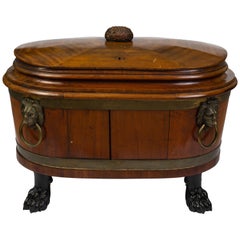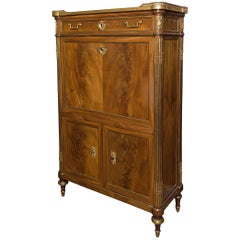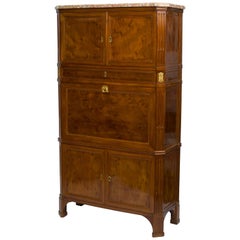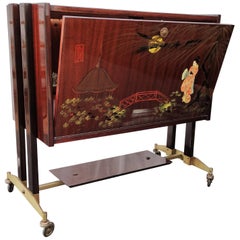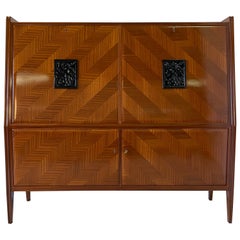Antiques Period LLC Cabinets
to
1
Height
to
Width
to
Depth
to
3
3
2
1
2
1
2
2
3
2
1
1
3
3
3
1
Regency Brass-Mounted Part-Ebonized Mahogany Cellarette
Located in Kittery Point, ME
Of oval form with a pomegranate finial, the hinged top opening to a fitted interior, and lion mask ring handles at the sides, raised on ebonized paw feet.
Category
Antique Early 19th Century English Regency Cabinets
Materials
Mahogany
Louis XVI Ormolu-Mounted Mahogany Secretaire Stamped Sotto
Located in Kittery Point, ME
With a canted white marble rectangular top with a three-quarter pierced gallery above a frieze drawer, the fall-front with gilt-tooled black leather writing surface enclosing a fitte...
Category
Antique Late 18th Century French Louis XVI Secretaires
Materials
Mahogany
$12,000 Sale Price
20% Off
Louis XVI Ormolu-Mounted Mahogany Secrétaire en Cabinet by Jean-Francois Leleu
By Jean-François Leleu
Located in Kittery Point, ME
The later breccia marble top over two paneled doors opening to reveal shelves, above a drawer over a fall front with an interior fitted with drawers and compartments, and two further...
Category
Antique Late 18th Century French Louis XVI Cabinets
Related Items
1950s Midcentury Regency Italian Wood, Brass and Mirror Dry Bar Cabinet Cart
By Vittorio Dassi, Guglielmo Ulrich, Paolo Buffa, Gio Ponti, Ico & Luisa Parisi
Located in Carimate, Como
Very elegant Italian Art Deco Mid-Century Modern dry bar cabinet cart characterized by its original Asian themed painted front wood pull-out tilt door with interior part in mirror glass, standing on its antique brass wheels...
Category
Mid-20th Century Italian Mid-Century Modern Dry Bars
Materials
Brass
$1,922
H 27.96 in W 28.75 in D 14.57 in
Italian Mahogany Secretaire Cabinet, 1950s
Located in Meda, MB
Precious cabinet secretaire produced in Italy in the 1950s,
The whole cabinet is veneered in mahogany with a fine solid wood carving in the center of the two doors representing two b...
Category
Vintage 1950s Italian Mid-Century Modern Cabinets
Materials
Mahogany, Maple
French Ormolu-Mounted Marqueterie Secretaire Abattant, Cabinet, 1775
Located in Rome, IT
Important French ormolu-mounted, kingwood, tulipwood and stained sycamore marqueterie and parquetry secretaire abattant with rectangular moulded white marble top, above a frieze draw...
Category
Antique 18th Century French Louis XVI Secretaires
Materials
Wood
$29,828 Sale Price
20% Off
H 55.91 in W 37.01 in D 15.75 in
Baker Styled Walnut Mahogany Bar / Sever Cabinet
By Baker Furniture Company
Located in Cincinnati, OH
A very well crafted two piece four door cabinet with book matched wood grained fronts opening to revel two glass and two wooden adjustable shelves with two smaller drawers one with d...
Category
Mid-20th Century American Mid-Century Modern Cabinets
Materials
Brass
Mahogany Drinks Cabinet, Dry Bar, Georgian Styling
By Bevan Funnell Ltd.
Located in Toronto, CA
A mahogany dry bar or drinks cabinet crafted in mahogany, Georgian styled with a delicate serpentine curve to the front to give it a classic line...
Category
20th Century European Georgian Dry Bars
Materials
Wood
Fine French Ormolu-Mounted Marqueterie Secretaire Abattant
Located in Rome, IT
A fine French ormolu-mounted, kingwood , tulipwood and stained sycamore marqueterie and parquetry secretaire abattant with rectangular moulded white marble top , above a frieze drawe...
Category
Antique 18th Century and Earlier French Louis XVI Secretaires
Materials
Fruitwood
$28,948 Sale Price
13% Off
H 55.91 in W 37.01 in D 15.75 in
Georgian Oval Mahogany Cellarette on Stand circa 1790
Located in Milford, NH
A fine George III carved oval mahogany cellarette with hinged crossbanded top, lion’s head round brass pulls on each side, and tin liner on a stand with four tapered inlaid legs, ter...
Category
Antique 1790s English George III Dry Bars
Materials
Brass, Tin
Baroque Cabinet with Secretaire, Germany 1750
Located in Belmont, MA
Add timeless elegance to your home or office with this original Baroque cabinet featuring a built-in secretary desk, crafted in Germany circa 1750. This exquisite piece originates fr...
Category
Antique 1750s German Baroque Cabinets
Materials
Walnut
Vintage Brazilian Mahogany Bar Cabinet 1970s Bamboo Boho MCM
Located in Lake Worth, FL
For FULL item description click on More Details below.
Shipping Quote Information
The shipping quote stated in the listing was from 1st Dibs and they normally set all the costs and handle all the shipping details. However, if you let us know what 1st Dibs is quoting you and give us your zip code, we can sometimes ship it for less and get it to you faster. For a shipping quote, click on "ASK THE SELLER" under the purchase button and provide your zip code.
Offering One Of Our Recent Palm Beach Estate Fine Furniture Acquisitions Of A
Vintage 1970s Brazilian Mahogany Bamboo Rattan Boho MCM Bar Cabinet...
Category
Vintage 1970s Mid-Century Modern Dry Bars
Materials
Bamboo, Rattan, Mahogany
$1,496 Sale Price
25% Off
H 67 in W 24 in D 14 in
Antique Georgian Regency Flame Mahogany Sarcophagus Wine Cellarette Cooler 1820
Located in Portland, OR
A fine antique Georgian Regency flame mahogany wine cellarette or cooler, circa 1820.
The sacophagus shaped cellarette having a band of carved eplipital decoration to the top and a gadrooned edge to the hinged lid, the slanted paneled base is raised on a plinth base with corresponding gadrooning and the original brass casters.
To the inside is the original galvanized zinc...
Category
Antique 1820s English Regency Dry Bars
Materials
Zinc
$2,495
H 25.25 in W 22.25 in D 17.5 in
Paul Evans Brutalist Sculpted Bronze Wall Mounted Disc Bar
By Paul Evans
Located in Miami, FL
Paul Evans Brutalist sculpted bronze wall-mounted disc bar cabinet,
Model PE-122.
This iconic bar features two doors concealing one drawer, one cabi...
Category
Vintage 1970s American Mid-Century Modern Dry Bars
Materials
Bronze
Art Deco Secretaire Cabinet by Jules Deroubaix
By Jules Deroubaix
Located in North York, ON
This Jules Deroubaix display cabinet secretaire is timeless, functional, and effortlessly chic. Made of burl sandalwood, it showcases a drop door paneled wit...
Category
Vintage 1930s French Art Deco Secretaires
Materials
Brass, Chrome
